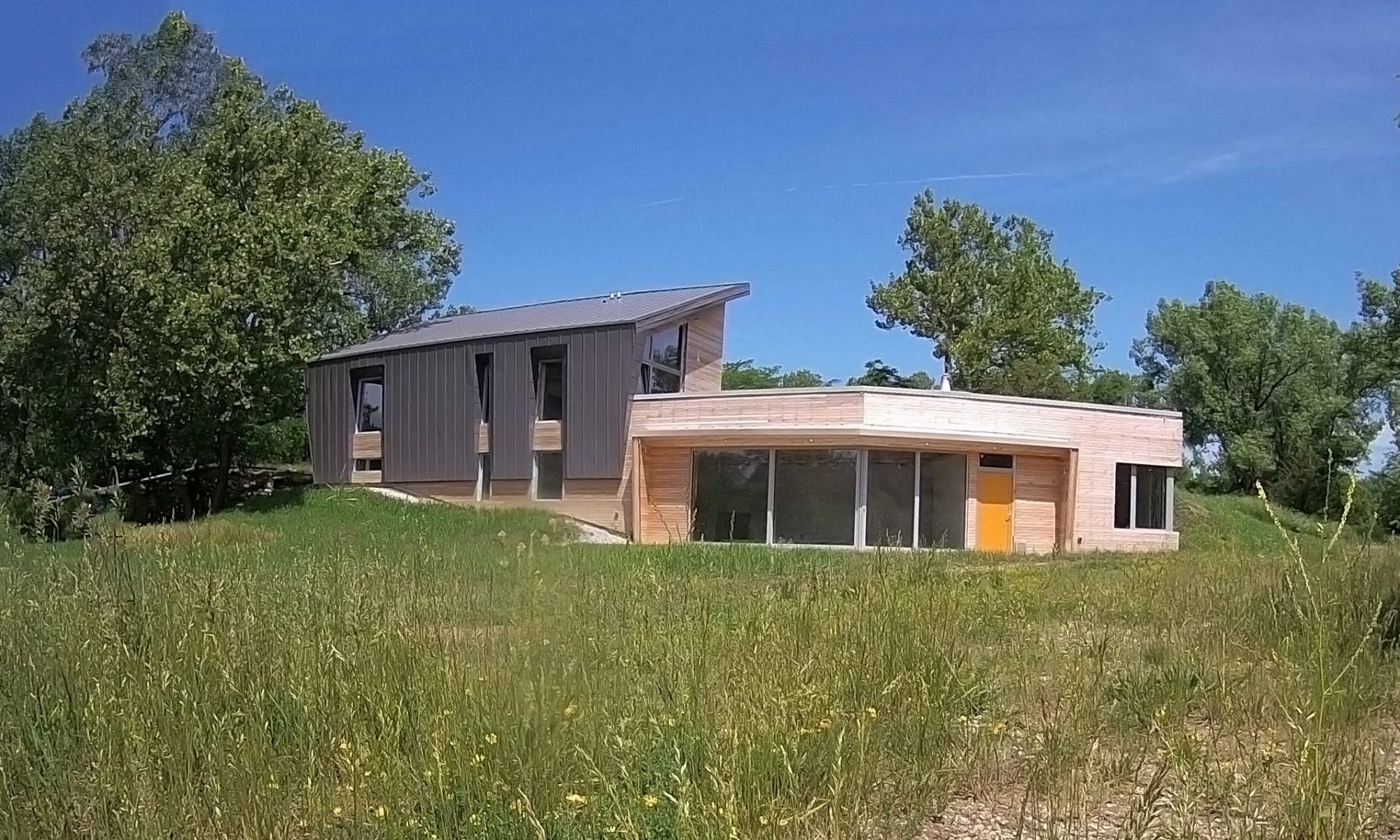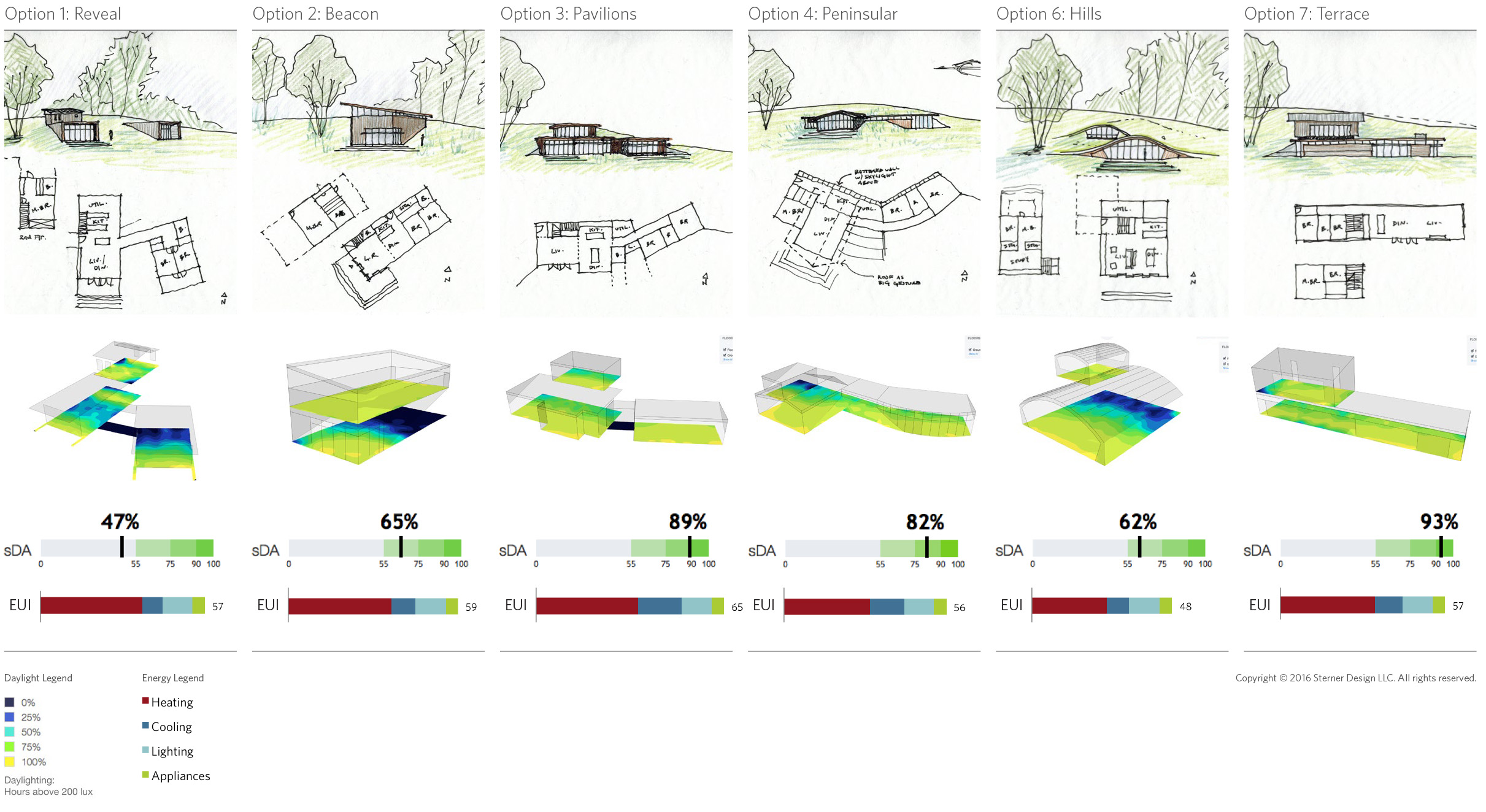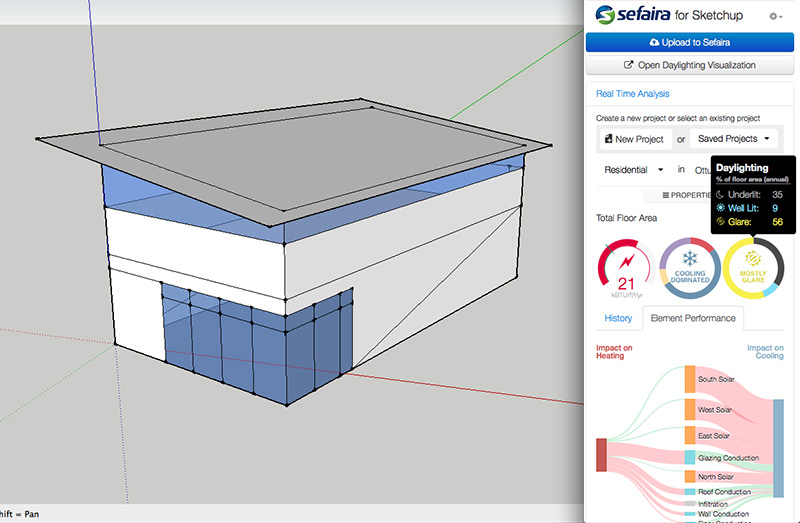I incorporated energy and daylight analysis as part of the conceptual design for the Iowa Nest Residence. This meant that early design discussions encompassed both traditional topics like floor plan layout, siting, and aesthetics, as well as performance criteria. The addition of analysis added a trivial amount of time, but proved incredibly valuable. Here’s how I did it — and what I will do differently next time.
Design Concepts & Performance Strategies
At this point I had already done a number of pre-design investigations related to passive strategies, Net Zero Energy, and avoidance of mechanical cooling. This meant that I had a pretty good idea of the passive design measures I wanted to employ, and had developed some initial design responses. These included:
- Earth berming
- “Volumetric” forms with thick walls, to facilitate high insulation and good air tightness
- Plentiful south-facing glazing, but limited glass on other orientations
- Good shading on the south
- Natural ventilation
The addition of analysis meant that we could discuss these strategies quantitatively, which helped bring the topic of performance to the fore. (In my experience this is often not the case, even for projects with ambitious performance goals.) The importance of including performance in these early discussions really can’t be overstated — it shapes the thinking of both client and designer in ways that are not otherwise possible.
The importance of including performance in early discussions can’t be overstated — it shapes the thinking of both client and designer in ways that are not otherwise possible.
Six of the design options, including perspective sketches, floorplans, and analysis, are below.
A few observations:
- Narrower floor plans tended to have better daylighting.
- A more compact form and/or more area underground tended to result in lower energy use.
- There is significant variation in both daylight and energy use just from varying building shape and glazing. This shows the importance of getting the basic design moves correct.
And finally, an observation about the process: Schematic design is about strategy. It’s about defining an approach that solves multiple interlocking problems. By incorporating performance at this stage we’re also implicitly defining a performance strategy: for example, “this building will meet its performance goals with a tight envelope and passive solar design;” or, “the envelope doesn’t matter as much as daylighting and lighting controls.” The design concept is necessarily the expression of an argument, a thesis, that must be supported by data. And without a clear strategy, it seems to me unlikely that a designer will come up with a clear concept.
And this is why, is my mind, performance analysis isn’t just a matter of achieving good performance. It’s also a matter of achieving good design.
How I Did It
Here’s the process I used:
- Brainstorm sketches (not shown): Classic “napkin sketches” I used to develop the ideas.
- Box model on site: For each option, I built an extremely simple box model in SketchUp, and located it on a topographic model. This helped me (1) understand the relationship to grade, and (2) perform quick energy and daylight studies.
- Analysis: I used Sefaira Architecture to do the analysis, using typical code values for envelope parameters. The purpose was not to predict final energy use or daylight levels, but rather to gauge the relative performance of each option.
- Presentation sketches: I traced over perspectives from SketchUp to create the final sketches.
The addition of analysis added a trivial amount of time to this process, but added tremendous value. This is in large part due to the speed and agility of Sefaira, and also due to the fact that I modeled with analysis in mind, keeping the models simple and using hand sketches for the presentation.
Lessons Learned
There are four things I would do differently:
- Isolate design decisions by starting with a great envelope. I would start with a Passive House envelope rather than a code minimum envelope. The goal at this phase is to isolate the impact of design decisions like building form, layout, orientation, and glazing design. A great envelope would remove the “noise” that comes from bad construction and highlight the importance of fundamental design moves.
- Include optimum shading for each design. Glass is almost always an energy liability if it is not properly shaded — but shading can shift the equation radically. It would have been easy to run a Response Curve in Sefaira for each concept to find the optimum shading length. This would have done two things: (1) forced me to consider shading as part of the design, and (2) more accurately reflected the impact of good passive solar design, rather than suggesting that designs with more glass are always poor performers.
- Look at room-by-room peak heating & cooling loads. Overall energy use is important, but as a design metric it risks missing “hot spots” and “cold spots” — rooms with high heating or cooling loads. These areas ultimately mean more complex & expensive mechanical systems, and/or thermal comfort issues.
- Ask “why?” Knowing that Option X has a high energy use is good, but even better is understanding why this is the case — for instance, that its energy use is driven by heat loss through the glazing. This tells you whether the problem is easily rectified or whether it’s intrinsic to the design. It is the actionable information that can directly inform future iterations.
One final note: Option 7, “Terrace,” is remarkably close to the final design. Its narrow floor plate made daylighting easy, which meant we could afford to reduce glazing and add shading, thereby reducing energy use markedly, without compromising experience. Its simple form also turned out to be significantly cheaper to build than some of the other options.
Unfortunately, it took several design iterations and re-designs to land back on this concept. Had we incorporated shading (lesson #2) and dug deeper into the energy results (lesson #4), its strengths would have become more apparent. Perhaps we should have paid closer attention to this early analysis: despite its faults it turned out to be remarkably prescient.



